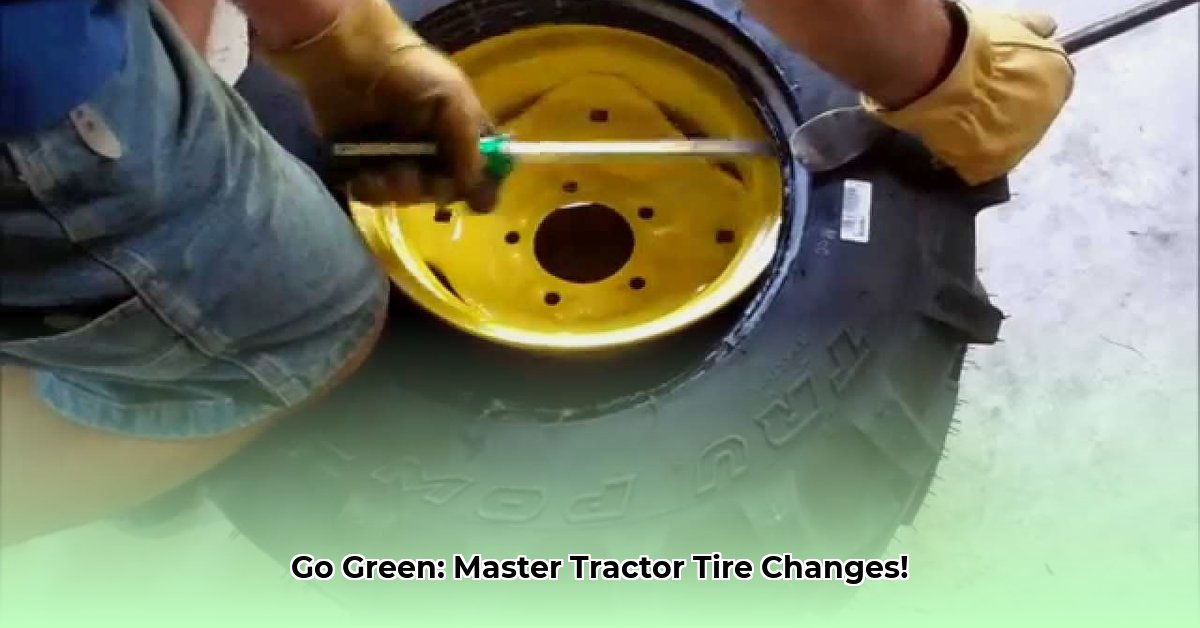
Changing Tractor Tires: A Step-by-Step Guide to Sustainable Farm Practices
Changing a tractor tire is more than just a repair; it's a crucial aspect of efficient and sustainable farm management. This guide provides a step-by-step approach, emphasizing safety and environmentally responsible practices. Did you know that improper tire disposal significantly impacts the environment? Let's explore how to minimize that impact while maximizing farm productivity. For more in-depth information, check out this helpful resource on tractor tire maintenance.
Step-by-Step Guide to Changing Tractor Tires
Safety First: Before beginning, gather necessary equipment: sturdy gloves, safety glasses, heavy-duty work boots, and wheel chocks. Remember, your safety is paramount.
Preparation: Park the tractor on a level, firm surface. Engage the parking brake, and securely wedge wheel chocks behind the wheels to prevent accidental movement. This simple step significantly reduces the risk of injury.
Lifting: Use a hydraulic jack with a weight capacity exceeding your tractor's weight. Position it correctly under the axle for stable support. Slowly lift the tractor until the tire is clear of the ground. Avoid rushing this critical step.
Wheel Removal: Employ a lug wrench of the appropriate size to loosen the lug nuts. It’s often easier to break them free before fully lifting the tractor. Once loosened, fully unscrew and remove the lug nuts and the wheel assembly.
Tire Removal: This step depends on tire size. Smaller tires may require strong tire irons. Larger tires usually necessitate specialized equipment, such as an air-powered tire changer. Protect the rim during this process to avoid damage.
New Tire Installation: Before mounting, inspect the new tire for any damage. Use lubricant (tire mounting lubricant or soapy water) to ease installation and prevent damage to the tire and rim. Follow the manufacturer’s instructions meticulously.
Reassembly: Carefully remount the wheel, ensuring the tire is correctly seated on the rim. Use a torque wrench to tighten the lug nuts to the manufacturer's specified torque. Never simply tighten them as hard as possible.
Lowering and Final Check: Slowly lower the tractor. Double-check that all lug nuts are securely tightened.
Sustainable Practices for Tractor Tire Management
The environmental impact of tractor tire management extends beyond the immediate change. Let's examine sustainable approaches:
Tire Disposal: Responsible Recycling and Disposal
Improperly disposed tires contribute significantly to landfill waste and environmental pollution. Explore these responsible alternatives:
Tire Recycling Programs: Many municipalities and private companies offer tire recycling programs. These programs either reclaim usable materials or convert tires into energy. Check your local regulations and options.
Retreading: Extending the life of a tire through retreading significantly reduces waste and overall carbon footprint. While cheaper initially, consider a tire’s overall lifespan when making choices.
On-Farm Repurposing: Repurpose old tires creatively for farm uses such as landscaping, weights, or other applications. This initiative minimizes waste and reduces landfill burden.
Tire Sourcing: Eco-Friendly Choices
Consider the environmental impact of tire manufacturing when selecting new tires:
Recycled Rubber: Opt for tires made with recycled rubber content whenever possible. These tires minimize the demand for new materials and reduce the overall environmental footprint.
Sustainable Manufacturing Practices: Research manufacturers committed to sustainable manufacturing processes that minimize environmental impact and prioritize worker safety.
Mechanization and Ergonomics: Enhancing Efficiency and Safety
Investing in mechanized tire changers can significantly improve efficiency and workplace safety, especially on larger farms.
Reduced risk of injury: Mechanization reduces the physical strain on workers, limiting the risk of musculoskeletal injuries.
Cost Savings: While the upfront investment is substantial, the long-term savings from reduced labor costs and increased efficiency outweigh the initial expense.
Faster Turnaround: Faster tire changes minimize equipment downtime, thereby increasing productivity.
Cost-Benefit Analysis: New Tires vs. Retreads
Choosing between new tires and retreads involves a careful cost-benefit analysis:
| Option | Upfront Cost | Lifespan | Environmental Impact | Labor Cost |
|---|---|---|---|---|
| New Tires | High | Longer | Higher (manufacturing) | Moderate |
| Retreaded Tires | Lower | Shorter | Lower (reduced production) | Moderate |
Key Takeaways:
- Prioritize safety: Always prioritize personal safety during the tire-changing process.
- Maximize lifespan: Proper maintenance and timely repairs extend tire life, reducing overall waste.
- Practice responsible disposal: Utilize local recycling programs and explore on-farm repurposing.
- Embrace sustainable practices: Choose eco-friendly tires and consider investing in tire-changing equipment.
- Conduct comprehensive cost-benefit analysis: Make informed decisions based on your farm's specific needs and resources. The long-term costs and benefits must be considered.
By implementing these sustainable practices, farmers can contribute to a greener future while maintaining efficient and productive operations.